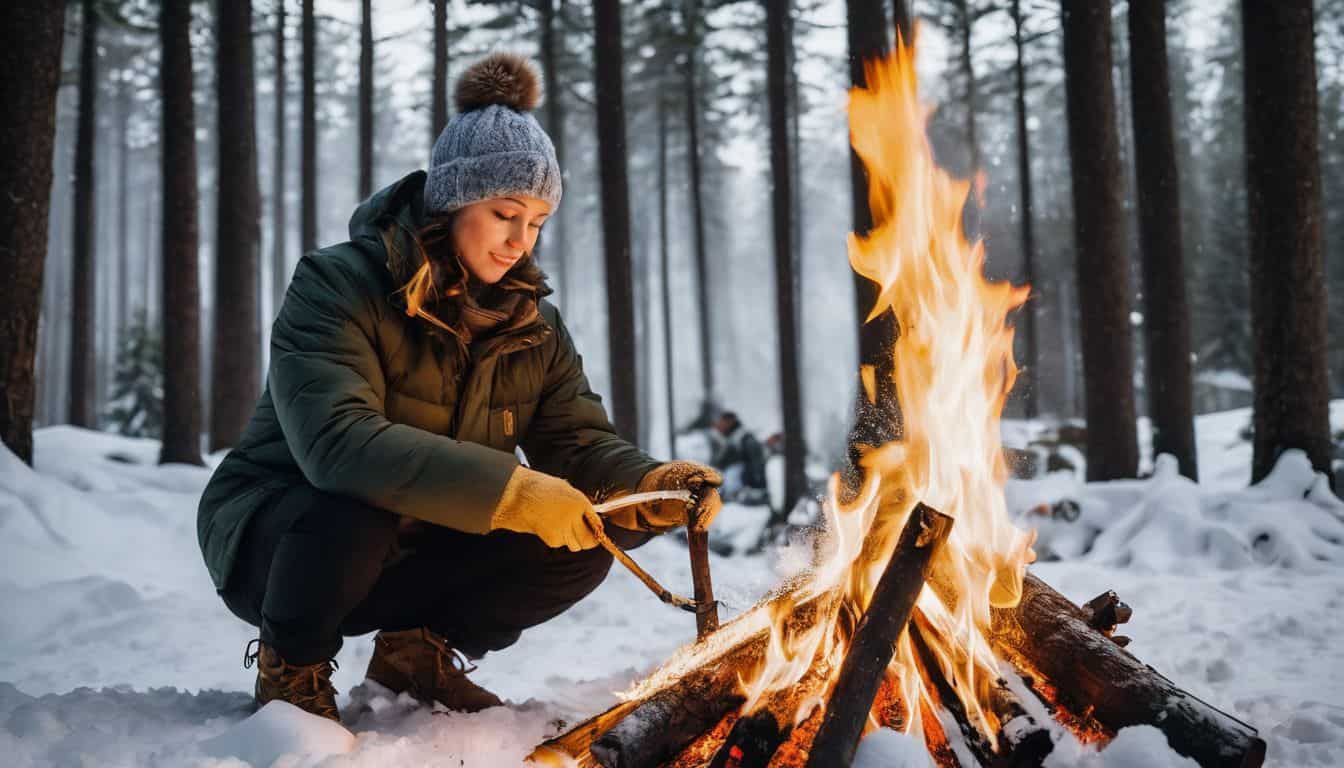Ever found yourself gaping at the resourcefulness of basic survival tools on those wilderness shows, questioning if you could craft something that inventive? Believe me, you’re not alone.
Stopping such a scenario from escalating into a terrifying reality begins with comprehending the art of constructing practical DIY survival tools. This blog is an amalgamation of lessons drawn from extensive research and personal trial-and-error experiences; it holds your hand through five methods to master this potentially life-saving skill.
Are you ready for this exhilarating challenge? Let’s bravely venture together!
Key Takeaways
- DIY survival tool crafting is a valuable skill that can increase your self – sufficiency and resourcefulness in the wilderness.
- You can make useful tools like prawn traps, spears, grass huts, bows and arrows, and cord drills using basic materials found in nature.
- Crafting your own survival tools is a cost – effective alternative to buying gear and allows you to personalize your tools for maximum effectiveness.
- Mastering essential skills like knot tying, woodworking, fire starting, and tool improvisation will enhance your ability to craft effective survival tools.
Basics of DIY Survival Tool Crafting
Making your own survival tools is a fun and useful skill. It starts with a basic cutting tool and the right piece of wood. The length of the wood matters. If it’s too short or too long, you may have trouble using your finished tool.
The first step is to choose what kind of tool you want to craft. A sharp-edged stone or knife can serve as your cutting tool. With these common items, you can start your DIY project.
Woodworking plays a big role in making survival tools by hand. Learning this old craft takes time but once mastered you’ll feel proud every time you use one of your handmade tools in the wild!
DIY Survival Tools You Can Make from Scratch
In this section, I will share with you five DIY survival tools that you can easily make from scratch. Each tool is practical and essential for increasing your skills and survivability in the wilderness.
Fresh Water Prawn Trap
I love making my own survival tools. One fun project is a trap to catch fresh water prawns. Here’s how I do it:
- I first gather what I will need: lawyer cane, vine, and sticks.
- Lawyer cane is sturdy yet bendable – perfect for making a trap.
- Vine helps to tie things together because it’s strong and flexible.
- Sticks give the trap its shape and strength.
- Now, onto making the trap!
- First, I remove the bark from the sticks using a sharp object.
- Then, I tie the sticks and lawyer cane together with vine to form a cage – like structure.
- The end result? An easy-to-build prawn trap that works well!
- Other folks may prefer using long thin sticks of willow or bamboo instead of lawyer cane.
- This DIY project isn’t just about catching prawns; it’s also about learning primitive survival skills.
Survival Spear
Let’s dive into making a survival spear. This is a handy tool you can craft from scratch. It helps in hunting and defending yourself in the wild. Here are the steps to make your own:
- Find a long, solid branch that will serve as the spear’s shaft.
- Use a sharp object like a knife or blade to whittle one end of the branch into a pointed tip.
- Make sure to carve the point carefully to avoid splitting the wood.
- Once done, you have crafted an effective survival spear using DIY techniques.
Grass Hut
Building a grass hut is an essential DIY survival skill. Here’s how you can make one using natural materials:
- Find a suitable location with enough space and resources.
- Gather long, sturdy branches for the frame of the hut.
- Use vines or strong cords to secure the branches together, creating a framework.
- Collect large leaves or pieces of bark to serve as roofing materials.
- Arrange the roofing materials on top of the frame, overlapping them to ensure waterproofing.
- Use smaller branches or sticks to reinforce the structure and provide stability.
- Secure everything with more vines or cords, tying them tightly.
- Make sure there is an entrance and proper ventilation in your grass hut.
Bow and Arrow
Making a DIY survival bow and arrow is essential for wilderness survival. Here are the steps:
- Find a sturdy stick or branch for the bow. Look for one that is about as tall as your arm span.
- Use a sharp stone or knife to remove any twigs or bumps from the branch.
- Attach a resilient cord or rope to each end of the branch, creating tension when pulled.
- Test the flexibility of the bow by bending it slightly. It should have some give but not break easily.
- Now, let’s make arrows! Find straight branches that are about as long as your forearm.
- Use your sharp stone or knife to shape one end of each branch into a point.
- Attach feathers or leaves near the other end of the branches to stabilize them in flight.
- To use your DIY bow and arrow, place an arrow on the string of the bow and pull back, aiming at your target.
- Release the string and watch your arrow fly!
Cord Drill
The cord drill is an awesome DIY survival tool that you can make from scratch. It’s made up of a flywheel, a shaft, and a piece of cord.
The Importance of DIY Survival Tools
DIY survival tools are crucial for self-sufficiency in the wilderness, resourcefulness in emergency situations, and as a cost-effective alternative to buying gear.
Self-sufficiency in the wilderness
Survival in the wilderness requires self-sufficiency and resourcefulness. Making your own DIY survival tools can help you achieve this. By crafting tools like woodcarved utensils and fishing hooks, as well as having handyman tools like pliers, saws, hammers, and clamps, you can be prepared for various situations that may arise in the wilderness.
It’s important to have these tools on hand to ensure your safety and increase your chances of surviving in the wild.
Resourcefulness in emergency situations
In emergency situations, being resourceful can be a lifesaver. It’s all about using what you have to make do. Whether it’s finding water in unexpected places or creating shelter from natural materials, resourcefulness is key.
For example, you can create a glowing bow drill ember by using unconventional items for friction. By practicing DIY survival skills and techniques, you’ll be better prepared to handle any crisis that comes your way.
It’s important to remember that in these situations, ingenuity and adaptability are essential for self-sufficiency and emergency response. So, don’t underestimate the power of resourcefulness when it comes to survival!
Cost-effective alternative to buying gear
As a survival enthusiast, I understand the importance of having the right gear in emergency situations. However, buying all the necessary equipment can be expensive. That’s why I recommend considering DIY alternatives as a cost-effective option.
By making your own survival tools, you can save money and still have reliable gear for any situation. For example, instead of buying an expensive survival knife, you can make one yourself using basic materials and following simple instructions.
It’s an economical way to ensure you have the essential tools without breaking the bank. So why spend more when you can create your own budget-friendly and effective survival equipment?.
Basic Skills Needed for Crafting Survival Tools
To excel in DIY survival tool crafting, you need essential skills like knot tying, woodworking, fire starting, and tool improvisation. Read on to learn how mastering these skills can increase your survivability in the wilderness.
Knot tying
Knot tying is an important skill for crafting survival tools. Knowing how to tie different knots can help you secure materials, build structures, and create traps. There are various knot techniques that you can learn, such as the overhand knot with a loop on a bight.
This knot provides a strong and reliable hold for your DIY projects. Learning basic knots is essential for survival situations, especially if you’re a prepper or enjoy outdoor activities like camping or hiking.
So take the time to practice your knot tying skills and become proficient in this basic survival skill today!
Woodworking
Woodworking is a crucial skill to have when it comes to crafting survival tools. With basic woodworking skills, you can excel in DIY tool crafting and increase your chances of survival in the wilderness.
By knowing how to hand-make primitive tools using wood, you can become more resourceful and self-sufficient during emergencies or outdoor adventures. Woodworking skills are not only useful for survival situations but also have practical applications in various fields.
They can even be listed on your resume as valuable skills that showcase your craftsmanship and problem-solving abilities. So if you’re looking to enhance your survival toolkit, honing your woodworking techniques is definitely worth it!

Fire starting
Fire starting is a crucial skill in survival. Fire provides warmth, light, and the ability to cook food and purify water. To start a fire, you need kindling, tinder, and fuel. Kindling is small twigs or dry leaves that catch fire easily.Tinder is fine materials like dried grass or paper that ignites quickly. Fuel refers to larger pieces of wood that sustain the fire once it’s lit.
There are different methods to start a fire without modern tools. For example, using friction with a bow drill or hand drill can create enough heat to ignite the tinder. Flint and steel can also be used by striking them together to create sparks that land on the tinder.
Remember, when starting a fire in the wilderness, safety is important. Ensure you have proper ventilation for smoke and keep flammable objects away from your campfire. Always make sure your fire is fully extinguished before leaving it unattended.
Tool improvisation
Tool improvisation is a crucial skill in DIY survival tool crafting. Knowing how to improvise with the materials available can help you create tools that meet your specific needs in different situations.
Whether it’s using a rock as a hammer or fashioning a spear from a sturdy branch, being resourceful and adaptable is essential for survival. By developing this skill, you can make the most out of your surroundings and increase your chances of thriving in any environment.
So, embrace your creativity and learn how to make the best use of what nature provides.
Safety Tips for DIY Survival Tool Crafting
Handle tools with caution, wear protective gear, and be aware of the limitations and risks associated with crafting survival tools.
Proper handling of tools
When it comes to crafting DIY survival tools, proper handling of tools is essential for your safety. Always follow tool safety precautions and use safe tool handling techniques. This includes wearing protective gear like gloves and goggles, using tools as intended, and being aware of the risks and limitations associated with each tool.
Remember to keep sharp objects out of reach when not in use, and always store them safely. By following these tips for handling DIY tools, you can ensure a safer experience while crafting your own survival gear.
Use of protective gear
Protective gear is very important when it comes to DIY survival tool crafting. When you’re using different tools, like knives and blades, it’s crucial to protect your hands from cuts or injuries.
That’s why wearing gloves made of cloth or leather can help keep your hands safe while working on your projects. Another safety tip is to make sure you follow DIY safety guidelines and use personal protective equipment like goggles or masks if needed.
Remember, taking precautions and using the right protective gear can prevent accidents and make your DIY survival tool crafting experience safer and more enjoyable.
Understanding limitations and risks
When crafting DIY survival tools, it’s important to understand the limitations and risks involved. One risk to be aware of is dust inhalation while sanding materials, which can be harmful to your health.
To protect your eyes, make sure you always wear quality safety glasses when working on projects. Chainsaws can also be dangerous if not handled properly, so it’s crucial to take precautions and avoid kickback incidents.
When using craft knives, remember to store them safely and handle them with care to prevent accidents. Being aware of these risks will help ensure your safety while enjoying the benefits of DIY survival tool crafting.
Essential Materials for Crafting Survival Tools
To create DIY survival tools, you’ll need natural materials like branches, rocks, and vines, as well as resilient cords and sharp objects such as knives or blades. Discover the key elements needed to craft your own survival gear and learn how to build essential tools from scratch.
Natural materials (branches, rocks, vines)
Crafting survival tools using natural materials like branches, rocks, and vines is an important skill to have in the wilderness. These organic materials can be used to create a variety of tools that are essential for survival.
For example, branches can be fashioned into spears or bows and arrows for hunting food. Rocks can be shaped into knives or cutting tools if you don’t have a blade on hand. Vines or cords made from natural fibers can be used for constructing shelters or securing items together.
By utilizing these resources found in nature, you can become more self-sufficient and resourceful in emergency situations. Plus, it’s a cost-effective alternative to buying expensive gear – all it takes is some knowledge of primitive skills and outdoor techniques to make the most out of these natural resources at your disposal!
Resilient cords and ropes
Resilient cords and ropes are crucial materials when it comes to crafting survival tools. They are durable, strong, flexible, and versatile, making them reliable in all kinds of situations.
These cords and ropes can be used for various purposes like building shelters, creating traps or snares for hunting food, securing items together, or even for emergency medical situations.
Their high-quality construction ensures that they can withstand the elements and provide long-lasting support. Whether you’re out camping or facing a survival situation, having resilient cords and ropes on hand is essential for your DIY tool crafting endeavors.
Sharp objects (knives, blades)
When crafting your DIY survival tools, it’s important to have sharp objects like knives and blades. These cutting tools are essential for various tasks in the wilderness. A fixed blade knife is considered the best option as it is sturdy and reliable.
You should also include a knife sharpener in your survival kit to keep your blades in top condition. Additionally, having a quality hatchet or saw can be useful for minimal survival needs such as building shelter or collecting firewood.
Remember to consider factors like hardness, sharpenability, and corrosion resistance when choosing knife steels. Having these sharp objects will greatly enhance your ability to craft effective survival tools and handle emergency situations with confidence.
Step-by-Step Instructions for Crafting Each Tool
To build the fresh water prawn trap, begin by cutting a plastic bottle in half and placing bait inside. Then, reattach the top of the bottle upside down as a funnel and secure it with tape.
Finally, attach a string to the trap for easy retrieval from the water.
Detailed instructions for building each tool
Let’s get started building these DIY survival tools! Here are the step-by-step instructions for crafting each tool:
- Fresh Water Prawn Trap:
- Find a sturdy container like a plastic bottle or can.
- Cut off the top part of the container.
- Make small holes near the bottom for water to flow in and out.
- Bait the trap with food like fish or meat.
- Place the trap in shallow water and secure it.
- Survival Spear:
- Find a long, straight stick or branch.
- Sharpen one end of the stick using a knife or blade.
- Optional: Attach a piece of cord or rope to create a throwing spear.
- Grass Hut:
- Choose an area with tall grass or reeds.
- Gather long and sturdy grass stems.
- Bend and intertwine the grass stems to create walls and a roof for your hut.
- Bow and Arrow:
- Find a flexible yet strong branch for your bow.
- Attach your string tightly between both ends of the bow.
- Craft arrows using straight sticks with pointed tips.
- Cord Drill:
- Find a thick stick or dowel as your drill base.
- Attach a cord to one end of the drill base by making a small hole and tying a knot.
- Hold onto both ends of the cord, wrap it around the drill base, and start spinning to create friction for drilling.
Tips and tricks for success
Crafting your own DIY survival tools can be a rewarding and empowering experience. To excel in this craft, there are some tips and tricks that can help you along the way. First, make sure to gather all the materials you need before you start crafting.
Being prepared will save you time and frustration later on. Secondly, follow the step-by-step instructions carefully and pay attention to details. Each tool has its specific techniques and methods, so follow them closely for successful results.
Another tip is to be patient and take your time while crafting. Rushing through the process can lead to mistakes or a poorly made tool. Take breaks if needed, but always return with a calm mind to continue working on your project.
Additionally, don’t hesitate to ask for advice or guidance from experienced crafters or survival enthusiasts. They may have valuable insights that can streamline your crafting process or offer alternative approaches.
Testing and Improving Your DIY Survival Tools
After crafting your DIY survival tools, it’s crucial to put them to the test in real-life scenarios and make necessary improvements for better performance and functionality.
Field testing and troubleshooting
Field testing and troubleshooting are important aspects of crafting DIY survival tools. Once you have built your homemade tools, it is crucial to test them in real-life scenarios to ensure their functionality and effectiveness.
Field testing allows you to identify any issues or shortcomings in your tools and make necessary improvements. It also gives you the opportunity to gain confidence in using your tools correctly.
During field testing, be prepared to encounter challenges and obstacles that may require troubleshooting. This could involve making adjustments or modifications to enhance the performance of your tools.
Making modifications for better performance
Making modifications for better performance is an important part of crafting DIY survival tools. When creating your own tools, it’s essential to test them out and make adjustments as needed.
By tweaking and refining the design, you can optimize its functionality and enhance its effectiveness. Additionally, upgrading certain components or adjusting measurements can greatly improve the tool’s overall performance.
It’s crucial to constantly test and improve your DIY survival tools to ensure they meet your specific needs in different scenarios. Remember, making modifications is all about customizing the tool to fit your requirements and increasing its reliability in survival situations.
Alternative Uses for DIY Survival Tools
DIY survival tools can also be incredibly useful beyond just survival situations. They have practical applications in camping, hiking, and other outdoor activities where having the right tools can make your experience much easier and more enjoyable.
Uses beyond survival situations
Survival tools aren’t just for emergencies, they can also be useful in other situations. For example, you can use a survival knife for camping or outdoor activities like fishing or cooking.
A paracord bracelet can come in handy when you need to tie something down or repair gear on the go. And a portable water filter can be used while hiking or traveling to ensure clean drinking water.
So even if you’re not faced with a life-or-death situation, having DIY survival tools can still be beneficial in everyday life. Just think of them as multipurpose tools that are there to help you no matter what challenges you may face.
Practical applications in camping and outdoor activities
In camping and outdoor activities, DIY survival tools have practical applications that go beyond emergency situations. These tools can be used to make tasks easier and more efficient.
For example, a survival spear can be used for fishing or hunting game while camping. A grass hut can provide shelter from the elements during overnight trips. A cord drill can help in starting a fire for cooking or staying warm.
Bow and arrow sets can be used for recreational activities like target practice or archery competitions. These DIY survival tools are not only useful in emergencies but also enhance the overall experience of outdoor adventures by providing solutions to various needs and challenges.
Conclusion on DIY Survival Tool Crafting
In conclusion, mastering the art of DIY survival tool crafting can greatly increase your skills and survivability in the wilderness. By learning to build your own tools from scratch, you become self-sufficient and resourceful in emergency situations.
Not only is it a cost-effective alternative to buying gear, but it also allows you to customize and personalize your tools for maximum effectiveness. So grab those branches, rocks, and vines, and start crafting your own homemade survival tools today!
FAQs on DIY Survival Tool Crafting
1. What is DIY survival tool crafting?
DIY survival tool crafting refers to the process of making tools and equipment that can be used in emergency or survival situations using readily available materials.
2. What are some common DIY survival tools I can make?
Some common DIY survival tools you can make include a fire starter, a water filter, a shelter, a signaling device like a whistle, and simple weapons like spears or slingshots.
3. Do I need any special skills to craft these survival tools?
While some advanced crafting skills may be required for certain tools, many basic DIY survival tools can be made with simple techniques that anyone can learn through online tutorials or guides.
4. Are the materials required for DIY survival tool crafting easy to find?
Yes, most of the materials required for DIY survival tool crafting are easy to find in nature or can be repurposed from everyday items such as plastic bottles, tin cans, or paracord.
5. How do these DIY survival tools help in emergencies?
These DIY survival tools help in emergencies by providing essential functions such as starting fires for warmth and cooking food, purifying water for drinking, building shelters for protection from harsh weather conditions, attracting attention through signaling devices when needing rescue or assistance, and defending oneself if necessary using homemade weapons.





Leave a Reply